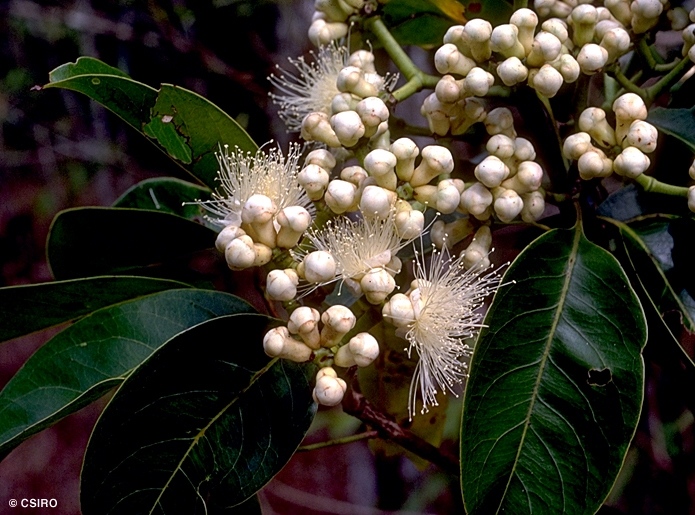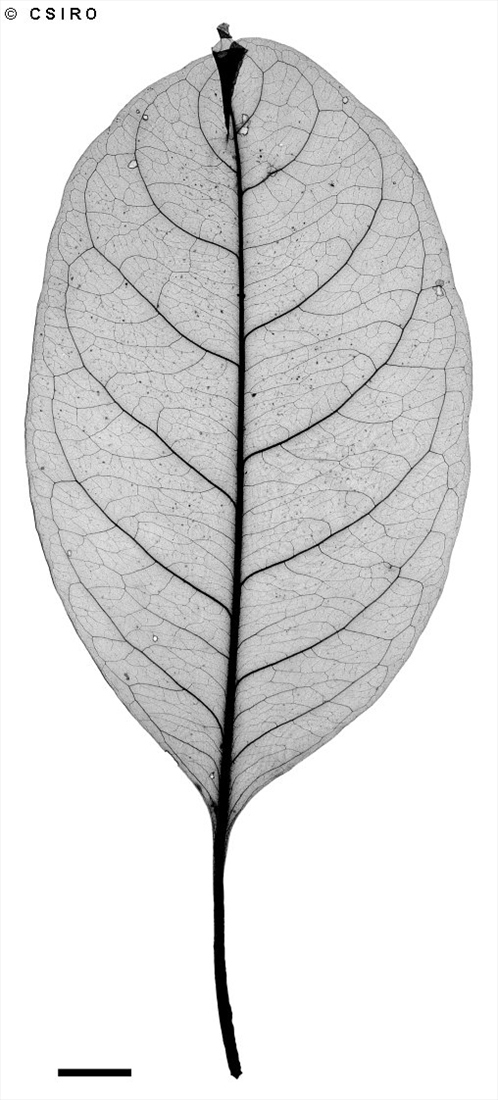Australian Tropical Rainforest Plants - Online edition
Syzygium bamagense B.Hyland






Hyland, B.P.M. (1983) Australian Journal of Botany Supplementary Series 9: 56. Type: B. Hyland 3579 RFK: Claudie River 18.xi.1977 (holotypus QRS).
Bamaga Satinash; Bamaga White Fruit; Satinash, Bamaga
Trunk normally without knobs or other processes.
Leaf blades fairly large, about 8.5-15.5 x 4.5-8 cm, petioles fairly long, about 1-3 cm long. Lateral veins not forming an intramarginal vein. Midrib depressed on the upper surface. Oil dots numerous, just visible to the naked eye, but readily visible with a lens. About 10-40 oil dots per reticulation.
Bracts mostly shed before anthesis, occasionally present, spathulate, about 2 mm long. Flowers +/- sessile, calyx tube (hypanthium) + pedicel (if present) about 5-10 mm long, tube (hypanthium) about 5-8 mm diam., calyx lobes somewhat reflexed at anthesis, +/- semicircular, dimorphic, outer lobes smaller, inner lobes about 3-5 mm long, margins hyaline. Petals orbicular, about 7-9 mm diam., oil dots numerous, more than 100 per petal. Outer staminal filaments about 10-21 mm long, anthers about 1-1.2 x 0.6 mm, gland terminal, near the back of the anther. Ovules about 5-10 per locule, placentas axile, central, ovules radiating, ascending. Style about 10-19 mm long, but generally not exceeding the stamens.
Fruits globular to ovoid, often somewhat irregular, about 35-60 x 35-46 mm, calyx lobes persistent, about 2-4 mm long. Seed solitary, about 20-40 x 20-38 mm, testa adhering slightly to the succulent pericarp but adhering very strongly to the rugose surface of the cotyledons by peg-like intrusions from the testa, cotyledons petiolate, uniformly textured, except for the peripheral layer. Radicle central-lateral.
Endemic to Queensland, occurs in CYP and just enters the northern part of NEQ at Cape Melville. Altitudinal range from sea level to 200 m. Usually grows in gallery forest along creeks and rivers but may also be found in drier, more seasonal forest. Not known from New Guinea but its occurrence there is a distinct possibility.
Although growing to a large well formed tree, this species occurs in a sparsely populated area and has only been utilized to a limited extent, mainly as a structural timber.
Wood specific gravity 0.96. Hyland (1983).





